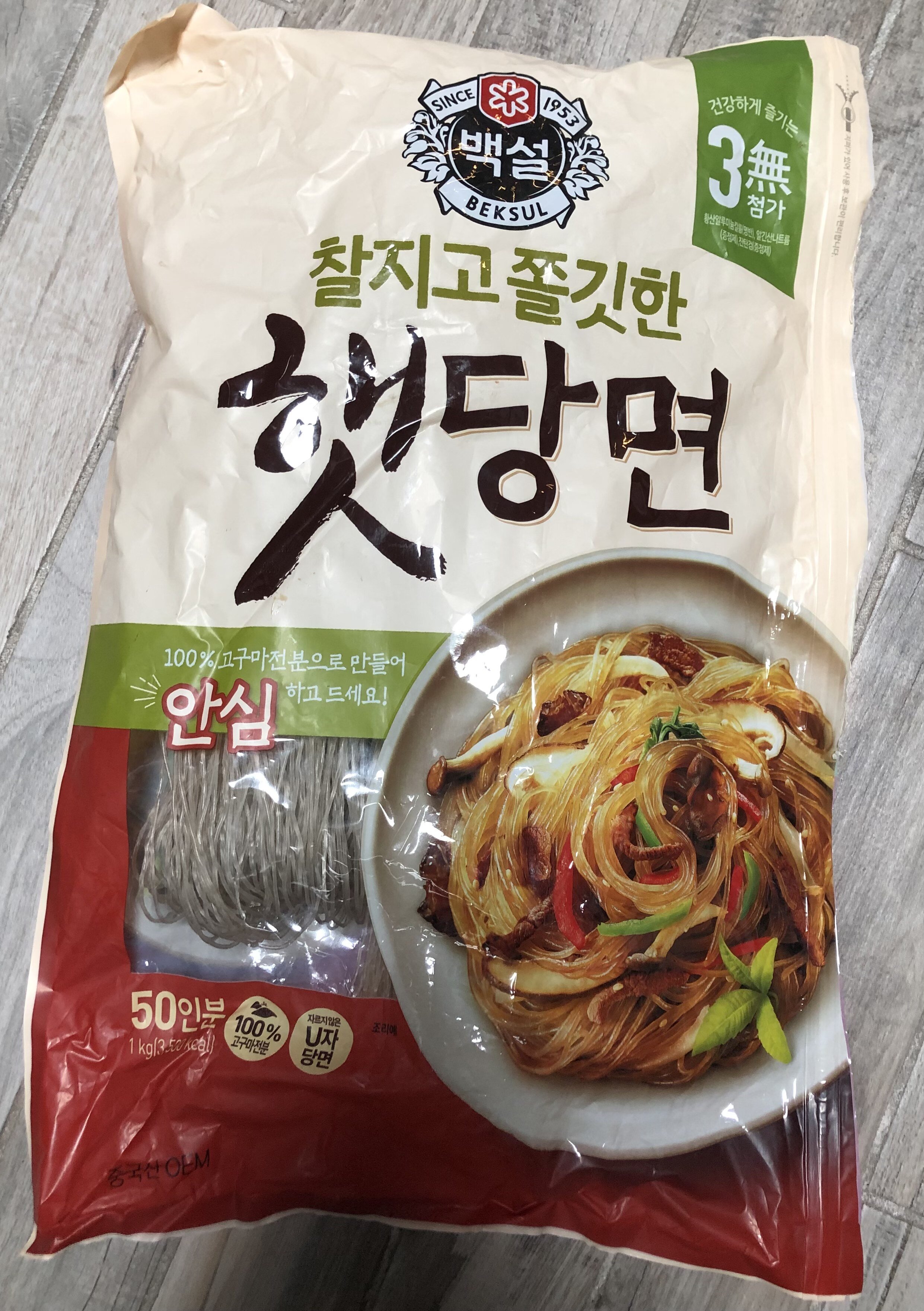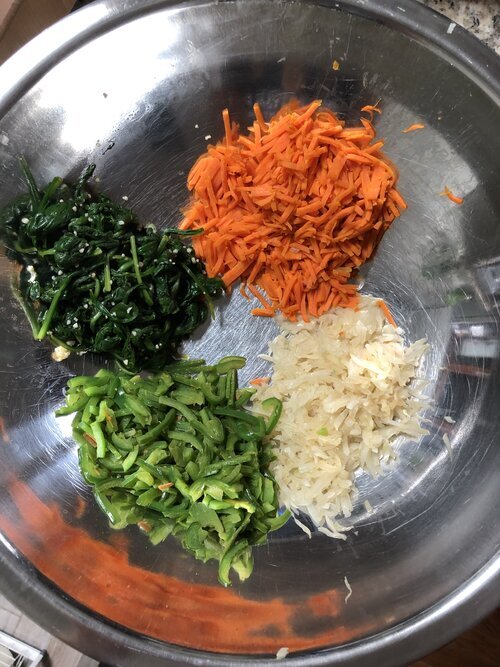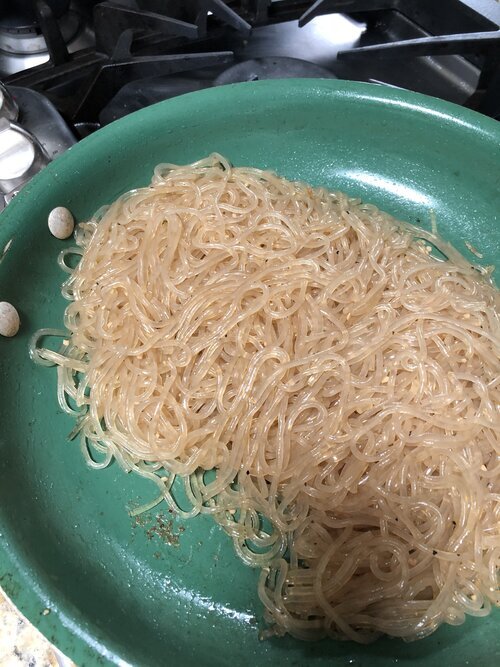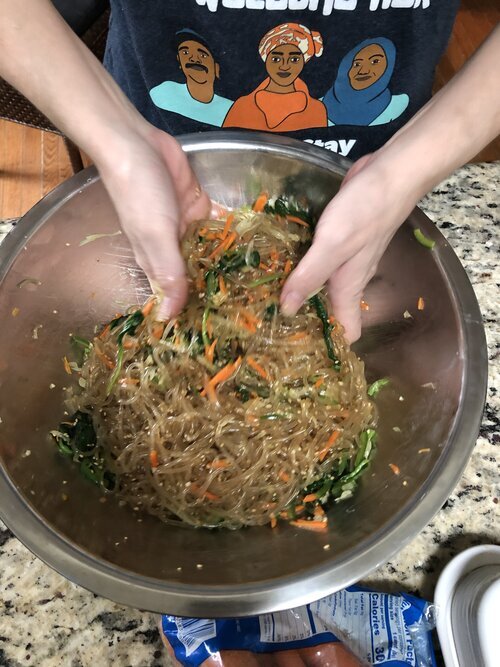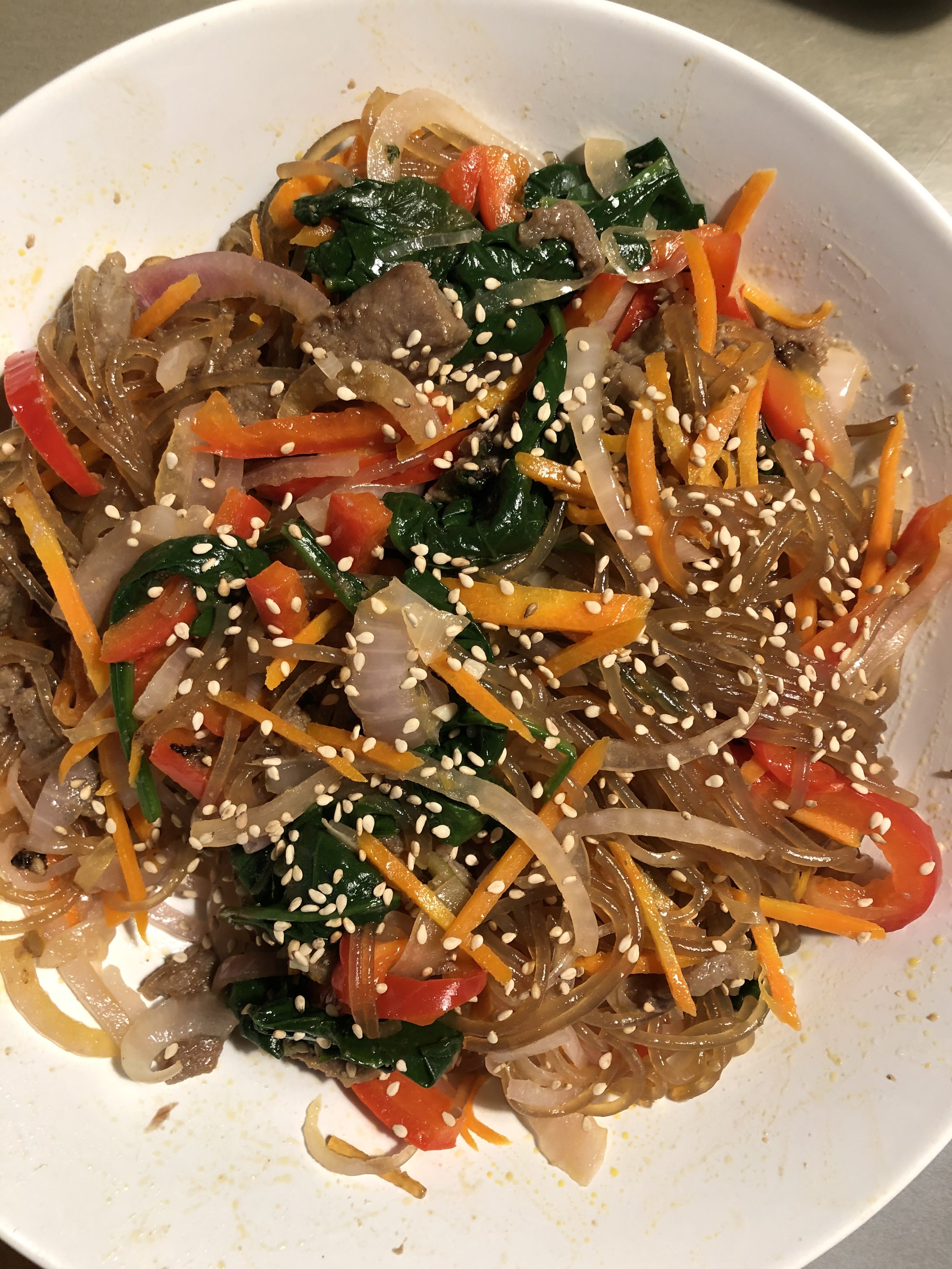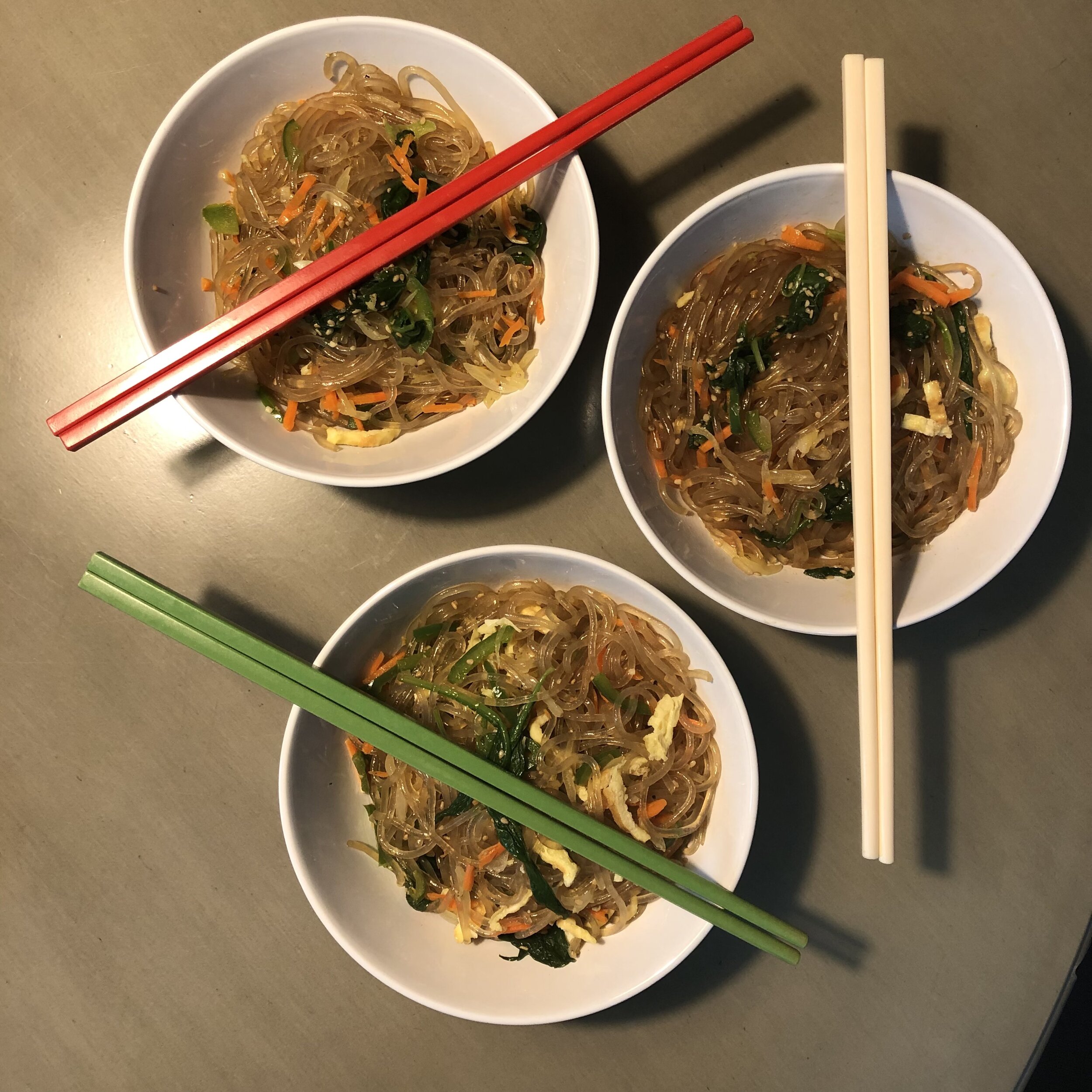Easy Authentic Japchae: Korean Glass Noodle Stir Fry Recipe
I recently made my first legit Korean dish. Japchae. After seeing all the yummy food on K-dramas it gave me a hankering for Korean food.
Even though there are any number of Korean restaurants within a 30 to 45-minute drive from me, between the coronavirus pandemic and the cost of eating out I wondered if I could successfully cook a Korean dish? Keep in mind I’m not your typical Korean. I grew up in Iowa in a white family. I’m a meat and potatoes girl who can double her calories at any meal with good bread. Because I’m not big on veggies or fruit and I don’t eat seafood I didn’t think Korean food would really appeal to me. Until I discovered bulgogi, kalbi, and brisket (which is very different from American brisket). Then I discovered japchae—just one of the banchan (Korean side dish) at one of my favorite Korean BBQ places, Breakers. Imagine my delight when my daughter Taylor and I discovered japchae at Costco! We were so excited we each bought a box.
Box. That should’ve been our first red flag! Even though it was the instant-type you make in the microwave I see them eating all types of instant noodles on K-dramas so I figured if it’s good enough for them it must be okay. Wrong. Now I realize why they usually apologize if all they have is instant noodles or why it’s a joke in the storyline if the person loves instant noodles. Or why they’re always eating it at a convenience store. In a pinch when there’s nothing else maybe. But don’t judge Korean food by their instant noodles. It would be like someone coming to America and judging mac-n-cheese solely on the box kind and not the dish you dream of—usually from the South—that’s made from scratch.
First of all it wasn’t cheap! Isn’t that half the reason you eat instant noodles? $15.99 for six containers. But the bowls were so big I was imagining slurping up all those delicious noodles. Long story short. When I made it I don’t think the container it came in was even half full and it tasted nothing like the japchae at Breakers. When I complained to my KAD sister-friend who goes to Korea a couple of times a year she told me to go to Hmart and buy glass noodles and make it myself. This is exactly what I did and I returned that “japchae” to Costco. My apologies to Ri Jeong-Hyeok (who can make his own noodles) for ever thinking I could get by with the instant version. ;)
I found a great recipe online at My Korean Kitchen that was authentic and looked pretty easy. I made a grocery list, and off to Hmart I went. It took me a bit to find just the right glass noodles, but after asking an employee I realized they’d been in front of my face the whole time (it said japchae right on the package). Hmart is one of those places that quickly makes me feel like I’m not a real Korean.
When watching Youn Yuh-Jung make japchae on Youn’s Kitchen 2 it made me feel legit to see her version was very similar to mine. It was also interesting to see how the chefs from the neighboring Restuarante Aristides were so intrigued with the noodles in japchae. Glass noodles are made from potato starch—sweet potato starch. They’re translucent, thus the reason they’re called glass noodles.
I make japchae pretty frequently because it is really easy. Turns out my KAD sister-friend had never made it before but when I sent her photos of how mine turned out she asked for the recipe. I have made a few tweaks to the recipe which you’ll find below.
More often than not I leave out the beef because my daughter Taylor is a vegetarian. If I have bulgogi I use that in place of the marinated ribeye. Because bulgogi is already marinated I can skip that portion of the recipe. If there are vegetarians present the (cooked) bulgogi can be added to individual servings.
I didn’t have rice bran oil so I used Olive oil for stir-frying. However, after reading up on the two oils and comparing, rice bran oil now sits on my counter next to my canola, EVOO, and sesame oils. Do NOT try to substitute the sesame oil, it has a very distinct flavor that would change up the dish big time.
The first time I made japchae I cooked the yolk and white separately as instructed. This makes for a prettier dish if you’re really into the aesthetics, and it is more authentic. But prepping and cooking the whole egg takes less time and I don’t really notice a change in the flavor because it’s mixed in with all the other flavors. I learned from Youn Yuh-Jung on Youn’s Kitchen 2 that the egg sheets should not be brown—but admittedly I don’t always succeed at this—but either does Jung Yu-Mi! The other thing to note is not to use too big or too small of a skillet to cook your egg(s). You don’t want that egg sheet too thin or too thick. Swirl the egg in the pan to make sure it spreads and cooks evenly. I like more protein, especially if I’m omitting the meat so I usually use two eggs instead of one. If I’m using more than 1 or 2 eggs (I usually double the entire recipe) the egg sheet will be made in the larger skillet so it’s more of a fold than roll to slice it into thin strips.
I use the same boiling water for the spinach and the noodles. I scoop the spinach out of the water rather than dumping to drain. This saves time and water. Make sure to drain the noodles well after running under cold water before putting in a large bowl with noodle & mushroom marinade.
In order to cut down on the number of dishes I use for prep, I transfer the stir-fried veggies to a dinner plate instead of the main bowl. I reserve the main bowl for the noodles and don’t add veggies to that bowl until I’m stir-frying the noodles. A dinner plate takes less room on the counter and in my dishwasher than two large bowls. Discovering shredded carrots in a bag has really cut down on my prep time—they’re the perfect little julienne strips—even better than slicing with my mandolin. Shhh—don’t tell that professional chef who trains Park Seo-Jun—who says Korean cooking is all about the hand work!
I prefer to stir fry my veggies separately like the My Korean Kitchen recipe suggests to make sure everything is evenly cooked. Red bell pepper is my favorite but depending on what I have on hand I’ve also used green, yellow, and orange.
I’ve yet to find a way to purchase only a few loose shitake mushrooms at a time, so I omit the mushrooms. I’m not a fan of mushrooms so an entire package would be wasted so I leave them out. When I do add them I will cut them smaller because I don’t like the texture and this will make them less obvious. I sound like a picky kid-eater, but some things you just don’t outgrow!
The recipe and step-by-step instructions I use are below. If you try making japchae let me know how it turned out in the comments below!
SHOPPING LIST
This section contains affiliate links. I may receive a commission for purchases made through these links—which helps support this blog—but at no additional cost to you!
Not everyone has accesst to five Hmarts like I do so I've tried to make it easy for you by providing links to the various ingredients you can purchase. When possible I prefer to use genuine Korean products but sometimes (even at Hmart) it's not possible.
These CJ Beksul Korean Vermicelli Dang Myun Glass Noodles are the same ones I get at Hmart. This is a 2.2 lb resealable bag and I usually have a couple on hand.
5.4 oz Chung Jung One Premium Sesame Oil
$8.99 + FREE SHIPPING with Prime or $25 order. This does NOT have a pineapple flavor as noted in their description, I think that's a misprint. As you can see in the photos above this is a brand I've used.
10.1 fl oz Chung Jung One Premium Sesame Oil
$17.95 + FREE SHIPPING with Prime or $25 order
16.9 fl oz Chung Jung One Premium Sesame Oil
Currently not in stock but wanted to share in case it comes back and you prefer this size in this brand.
10.82 fl oz Premium Roasted Ottogi Sesame Oil
AMAZON CHOICE $12.95 + FREE SHIPPING with $25 order
16.9 fl oz Premium Roasted Ottogi Sesame Oil
"AWARD WINNING: “The Best Sesame Oil You Can Buy” – Business Insider 2018 ""Best Toasted Sesame Oil"" on Cooks Illustrated - 2020" $15.99 + FREE SHIPPING with Prime or $25 order
56 fl oz Premium Roasted Ottogi Sesame Oil
$29.99 + FREE SHIPPING! According to Ottogi they're the best and biggest manufacture of food products in South Korea. Since I'm not in Korea I can only vouch for my success in using this brand's products. This is the same oil I had my daughter buy the last time we were at Hmart.
8 oz Iri Goma Roasted Sesame Seeds
$8.88 + FREE SHIPPING with Prime or $25 order. These are Japanese but the same ones I purchased at Hmart.
3.5 oz Ottogi Roasted Sesame Seeds
AMAZON CHOICE $8.97 + FREE SHIPPING with Prime or $25 purchase. This is a Korean brand, the same as the sesame oil above.
25.3 fl oz Baja Precious Rice Bran Oil
AMAZON CHOICE $9.99 + FREE SHIPPING with Prime or $25 order. 100% Pure Rice Bran Oil.
5-pairs Stainless Steel Chopsticks
AMAZON CHOICE $6.95 + FREE SHIPPING with Prime or $25 order. If you want the full experience you need chopsticks. I have a heavier set and this lightweight set. I tend to use these the most because they're easier. Made from premium 304 stainless steel with a fine polished finish to prevent rusting and overheating. They are very durable, easy to hold, and dishwasher safe.
5-pairs Stainless Steel Chopsticks - Gold
AMAZON CHOICE $9.99 + FREE SHIPPING with Prime or $25 order. These are heavier but these are the first type I purchased (in silver) because I liked the shape which matches the handle shape of my Korean long-handled spoons. I'm thinking I might have to jump on the gold bandwagon. Dishwasher Safe Chopsticks, 304 Stainless Steel, Easy to Use (No Color Fading)
8-Piece Stainless Steel Long-Handled Korean Spoons
AMAZON CHOICE $11.99 + FREE SHIPPING with Prime or $25 order. Currently there's an extra $4 off coupon you can click to save 25%. No, you don't need these spoons to eat bulgogi but if you're serving rice or soup they'll come in handy. Honestly, I love the long handles and I find myself using these even when I'm not eating Korean food.
8-Piece Stainless Steel Long-Handled Korean Spoons in GOLD
$12.99 + FREE SHIPPING with Prime or $25 order. Gold utensils are all the rage these days. These are the same long handled spoons but with a brushed gold finish.
Maangchi's Real Korean Cooking: Authentic Dishes for the Home Cook 2015 [HARDCOVER]
$17.99 + FREE SHIPPING with Prime or $25 order HARDCOVER Maangchi's cookbooks should be a staple in the kitchen of anyone who wants to make authentic Korean recipes! My copy of Maangchi's cookbook is full of bookmarks for recipes I've made or want to try!
Maangchi's Real Korean Cooking: Authentic Dishes for the Home Cook 2015 [KINDLE]
$14.99 if you'd rather have the Kindle version.
Maangchi's Big Book of Korean Cooking: From Everyday Meals to Celebration Cuisine 2019 [HARDCOVER]
EDITOR'S PICK $17.55 + FREE SHIPPING with Prime or $25 purchase I have this cookbook too! If you want authentic Korean recipes you can't go wrong with Maangchi! The New York Times Best Cookbooks of Fall 2019, Eater Best Fall Cookbooks 2019, Bon Appetit's "Fall Cookbooks We've Been Waiting All Summer For", Amazon's Pick for Best Fall Cookbooks 2019, Forbes Finds 15 New Cookbooks for Fall 2019
Maangchi's Big Book of Korean Cooking: From Everyday Meals to Celebration Cuisine 2019 [KINDLE]
$19.99 for the Kindle version.
Opened Google one day to find this recipe blog post featured right under news about Stray Kids! How did you find this post, was it a suggestion from Google? Let me know in the comments!
MORE AUTHENTIC KOREAN RECIPES
Click on any title to see full recipe


